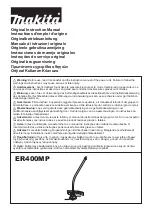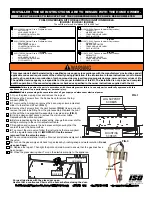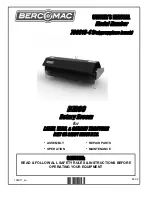
DEUTSCH
ENGLISH
ENGLISH
Thank you for choosing one of our products; we hope you
will have long, pleasant flights in your harness. When we
design our products, we pay particular attention to all
aspects of comfort, durability and safety. This document
has been written to help you get to know your harness and
make the best possible use of it.
Thank you for the time you spend reading the next few
pages.
After you have carefully read this manual, we sug-
gest that you try out your harness in a static swing
before you go for your first flight, and in this way
you can:
■
Check that each adjustment is correct.
■
Practice the movement from standing to sitting and sit-
ting to standing.
■
Check that your parachute is correctly set up and
practice the correct movement for pulling it out and
throwing it.
■
Practice harness adjustments on the ground before
doing it during a flight.
WARNING
Paragliding is a relatively dangerous sport, so
it is important that you do not forget certain basic rules
for safe flying. Before flying, make sure that the weather
conditions, your physical condition and your equipment
are such that you can undertake this flight under the best
possible conditions. Throughout this manual we will advi-
se you on how to adjust your harness and use it correctly.
Take great care to look after your harness. Check the
condition of the straps and seams regularly.
Avoid leaving your harness exposed to the sun for a long
time, and above all, avoid leaving it in damp conditions
for long periods.
You must make a habit of regularly checking that your
equipment is in good condition for flying. If you have any
questions about the use of this equipment, please contact
us at SUP’AIR, or your regional dealer.
SUP'AIR
Z.I. de Vovray
14, avenue des Vieux Moulins
74OOO ANNECY FRANCE
Tél : +33 (0) 4.50.45.75.29
Fax : +33 (0) 4.50.52.78.70
[email protected]
Depending on the model, your harness can be
equipped with the following:
■
Bump’Air or "Cygnus airbag" type back protection.
■
Integrated reserve parachute pocket, which can be in a
lateral, back, front, top or underseat (XC, XC 6) filup
position.
■
Quick and easy buckles and adjusters.
■
Safe-T-Bar (reminder device) system, to prevent the
pilot falling out of the harness in flight.
■
A large storage pocket for the paraglider bag and other
items.
■
Two-point connection for the reserve parachute integra-
ted into the shoulder straps with a covering closed by a
piece of Velcro
®
.
■
SUP’AIR Auto Balance System; a floating webbing system
integrated into the chest strap and the base plate.
■
Side pockets which are accessible during flight.
■
Variable-angle seat extension or dual block base plate
for maximum in-flight comfort
■
Accelerator pulleys and elasticated guide-rings for easy
use of the accelerator.
■
Accelerator auto return system
■
Elasticated shoulder straps to prevent them falling off in
flight and assisting entry into the harness.
It is also possible to equip SUP’AIR harnesses with
the following accessories, depending on the
model:
■
Lateral protections,
■
Cockpit with a ballast or reserve parachute pocket,
■
Carbon seat plate,
■
Foot stirrup,
■
Vario holder.
Unless there are specific limitations imposed by the
manufacturer of the paraglider, your harness can be used
with all types of paraglider.
OPERATION, INSTALLATION AND WARNING
RELATING TO THE SUP'AIR "PERMANENT
AIRBAG" PROTECTION SYSTEM
The BUMP’AIR “permanent airbag” protections made by SUP’AIR for har-
nesses are compatible with most recent harnesses, provided there is adequa-
te space available in the back of the harness.
It is important that the BUMP’AIR is not compressed in normal use, and that it
does not reduce the seat area. It is also necessary to check that the protection
is appropriately fixed in a central position in such a way that it will not move.
If the Bump’air is correctly positioned and of the correct size, it should have
no effect on the comfort of the harness.
OPERATION
The BUMP’AIR made by SUP’AIR is a real “permanent airbag” (inflatable
cushion). It’s function is similar to that of a car airbag. The kinetic energy of
a fall is smoothly absorbed by the air escaping progressively through the
seams. The BUMP’AIR “permanent airbag” is kept inflated by foam which
springs back to its original shape, thus ensuring that it is always ready. The
adiabatic curve for the air when it is being compressed is such that the
cushioning effect increases smoothly.
Naturally, a “permanent airbag” protection system cannot completely elimi-
nate the risk of injury resulting from a fall, but they can help to reduce their
frequency and seriousness. Never forget that the best landing gear is still a
pair of human legs!
INSTALLATION OF THE BUMP’AIR
Simply slide the protection into the space for it under the base plate and
behind the back support. It is then necessary to check that the protection has
all the space that it needs and that deployment of the reserve parachute is not
hindered, and that the pilot is seated in a comfortable position which enables
him to fly correctly.
If any straps cross the space where the protection is to be installed, check that
these straps are on the pilot's side i.e. that the protection is NOT inserted bet-
ween the pilot and the straps.
WARNING:
the BUMP’AIR must neither be too compressed nor able
to "float about" in the area intended for it.
The attachment of the BUMP’AIR to the harness may be done by
using lateral strips of Velcro
®
(see diagram). In this case the Velcro
®
strips
must be attached without any tension. The BUMP’AIR 20 or the BUMP'AIR 17
Plus are simply slotted into their space. We recommend the BUMP’AIR 20 for
size XL and XXL harnesses. The BUMP’AIR 17 and 17 Plus are suitable for all
other types of harness. The BUMP’AIR model recommended for each new
SUP’AIR harness is indicated in its handbook.
BEFORE FLYING, CHECK:
■
the rescue handle position,
■
the parachute pin position,
■
that the carabiners/maillons are closed
and locked,
■
that the front pod has been correctly adjusted,
■
that the leg straps are correctly tightened.
17
16
---Notice SUPAIR 2702_GB_DE 10/03/03 15:21 Page 16
























